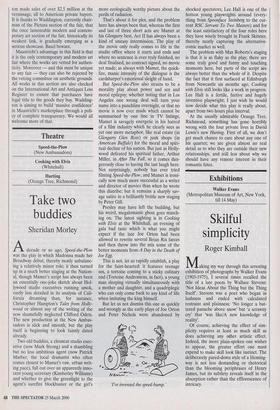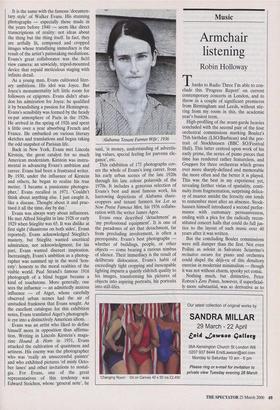Exhibitions
Walker Evans (Metropolitan Museum of Art, New York, till 14 May)
Skilful simplicity
Roger Kimball
Making my way through this arresting exhibition of photographs by Walker Evans (1903-1975), I several times recalled the title of a late poem by Wallace Stevens: 'Not Ideas About the Thing but the Thing Itself'. Stevens was a poet who began in lushness and ended with calculated restraint and plainness: 'No longer a bat- tered panache above snow' but 'a scrawny cry' that 'was like/A new knowledge of reality'.
Of course, achieving the effect of sim- plicity requires at least as much skill as does achieving any other artistic effect. Indeed, the more plain-spoken one wishes to appear, the greater effort one must expend to make skill look like instinct. The deliberately pared-down style of a Heming- way is not less demanding or rhetorical than the blooming periphrases of Henry James, but its subtlety reveals itself in the absorption rather than the efflorescence of intricacy. It is the same with the famous 'documen- tary style' of Walker Evans. His stunning photographs — especially those made in the years before 1940 — seem like direct transcriptions of reality: not ideas about the thing but the thing itself. In fact, they are artfully lit, composed and cropped images whose transfixing immediacy is the result of the artist's painstaking mediations. Evans's great collaborator was the 8x10 view camera: an unwieldy, tripod-mounted device that repaid meticulous staging with infinite detail.
As a young man, Evans cultivated liter- ary ambitions. His idol was Joyce. But Joyce's monumentality left little room for followers or epigones. Evans didn't aban- don his admiration for Joyce: he qualified it by brandishing a passion for Hemingway. Evans's sensibility was formed by the heady ex-pat atmosphere of Paris in the 1920s. He arrived in the spring of 1926 and spent a little over a year absorbing French and France. He embarked on various literary sketches and translations and began taking the odd snapshot of Parisian life.
Back in New York, Evans met Lincoln Kirstein, the great catalyst for so much American modernism. Kirstein was instru- mental in advancing Evans's ambition and career. Evans had been a frustrated writer. By 1930, under the influence of Kirstein and others, he began to realise his true metier. 'I became a passionate photogra- pher,' Evans recalled in 1971. 'Couldn't think about anything else. I just caught it, like a disease. Thought about it and prac- tised it all the time, day by day.'
Evans was always wary about influences. He met Alfred Stieglitz in late 1928 or early 1929 when Stieglitz was 65. It was dislike at first sight ('disastrous on both sides', Evans reported). Evans acknowledged Stieglitz's mastery, but Stieglitz wanted uncritical admiration, not acknowledgment; for his part, Evans wanted discreet inspiration. Increasingly, Evans's ambition as a photog- rapher was summed up in the word 'hon- esty': honesty to the moral realities of the visible world. Paul Strand's famous 1916 photograph of a blind beggar became a kind of touchstone. More generally, one sees the influence — an admittedly anxious influence — of Atget, whose carefully observed urban scenes had the air of unstudied frankness that Evans sought. As the excellent catalogue for this exhibition notes, Evans translated Atget's photograph- ic eye into a distinctively American idiom. Evans was an artist who liked to define himself more in opposition than affirma- tion. Writing in Lincoln Kirstein's maga- zine Hound & Horn in 1931, Evans attacked the cultivation of quaintness and artiness. His enemy was the photographer who was 'really an unsuccessful painter' and who exhibited pictures 'of misty Octo- ber lanes' and other invitations to nostal- gia. For Evans, one of the great representatives of this tendency was Edward Steichen, whose 'general note', he Alabama Tenant Farmer Wife', 1936 said, 'is money, understanding of advertis- ing values, special feeling for parvenu ele- gance', etc. This exhibition of 175 photographs cov- ers the whole of Evans's long career, from his early urban scenes of the late 1920s through his late colour polaroids of the 1970s. It includes a generous selection of Evans's best and most famous work, his harrowing depictions of Alabama share- croppers and tenant farmers for Let us Now Praise Famous Men, his 1936 collabo- ration with the writer James Agee.
Evans once described 'detachment' as 'my professional equipment'. It is one of the paradoxes of art that detachment, far from precluding involvement, is often a prerequisite. Evans's best photographs — whether of buildings, people, or other objects — come bearing a curious nimbus of silence. Their immediacy is the result of deliberate dislocation. Evans's habit of exceedingly tight cropping and inescapable lighting imparts a quietly eldritch quality to his images, transforming his pictures of objects into aspiring portraits, his portraits into still-lifes.



































































 Previous page
Previous page